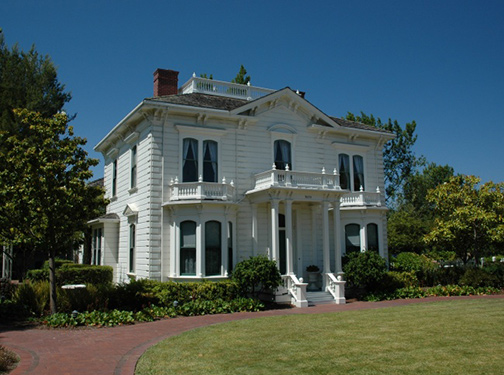 Palo Alto Stanford Heritage
Palo Alto Stanford Heritage 
Lured by tales of the California gold rush, Henry Rengstorff left his native Germany at the age of 21. He sailed around Cape Horn and arrived in San Francisco in 1850—too late for the promised riches. With only $4 to his name, he worked for three months on the Jack Robinson, a steamer plying the bay between San Francisco and Alviso. For the following three years, he toiled as a farm laborer in San Jose.
Rengstorff was intelligent, shrewd and thrifty and longed to be his own boss. In 1853, taking advantage of “squatters rights”, he acquired 290 acres of San Jose land. Three years later, he added another 290 acres. The profits from these lands, which he worked on his own or rented to tenant farmers, led ultimately to the acquisition of over 10,000 acres in Los Altos, Milpitas, San Jose and San Mateo County. It also led to the prosperity of his youthful dreams.
The land purchase that Rengstorff would call “home” was a 164 acre ranch purchased in 1864. It was located in Mountain View where Shoreline Business Park is today. Here he built a dock, store and warehouse, thus adding a commercial enterprise to his agricultural empire. Shipments of grain, lumber and produce from the valley and hills brought to the Rengstorff Landing found their way to market by water. Returning ships brought hardware and building supplies for the growing region. Rengstorff Landing played a significant role in the economic development of Mountain View and the Peninsula.
Not far from the Landing, Rengstorff built an elegant house for his wife, Christine Hassler, a German immigrant whom he’d married in 1857. Here they raised their seven children and became prominent pioneer citizens. Henry helped found Whisman School, later serving as a School District trustee, and he and his wife were trustees of the Presbyterian Church.
The Rengstorff House, built in 1867, is one of the finest examples of Victorian Italianate architecture on the west coast. The romantic Italianate was the most popular of the Victorian styles. House pattern books with designs by A. J. Downing, Calvert Vaux and Alexander Jackson Davis swept the nation.
Italianate design is evident in the symmetrical façade of 3070 Shoreline. A pair of columns support the front portico, which is flanked by matching bay windows with identical arched windows above them. Both portico and bays are topped by balustraded balconies. The low pitch of the hip roof, with its wide bracketed eaves, is accentuated by the long widow’s walk, the central gable and the two matching brick chimneys. Typical Victorian touches can be seen in the five–paneled front door with beaded detailing and in the arched tops of the tall, double–hung windows.
This 12–room, 3,955 square foot house has 10–foot ceilings on the second story and 11–foot ceilings on the first. Framed in Douglas fir, the house uses rustic redwood for its siding, gutters and interior wainscot.
Ornate marble fireplaces adorn the four main rooms on the first floor: the formal parlor, the library parlor, the family parlor, and the men's smoking parlor, which has a black marble fireplace. A large dining room, kitchen and wraparound porch complete the downstairs. The second story has four family bedrooms, a sewing room and servants’ quarters. These rooms are detailed with cove moldings, picture rail and chair rail.
Henry Rengstorff died in 1906 but his wife and their descendants continued to live in the house until 1959. It fell into a state of disrepair and was purchased for $1 by the City of Mountain View in 1979. During the 1980’s, the house was moved to its present location and rehabilitated. Today, it sits proudly in Shoreline Park, beckoning visitors. ©
PAST, October 4, 2013
E-mail us at either webmaster@pastheritage.org or president@pastheritage.org.
![]() Palo Alto Stanford Heritage—Dedicated to the preservation of Palo Alto's historic buildings.
Palo Alto Stanford Heritage—Dedicated to the preservation of Palo Alto's historic buildings.
Copyright © 2015 Palo Alto Stanford Heritage. All rights reserved.